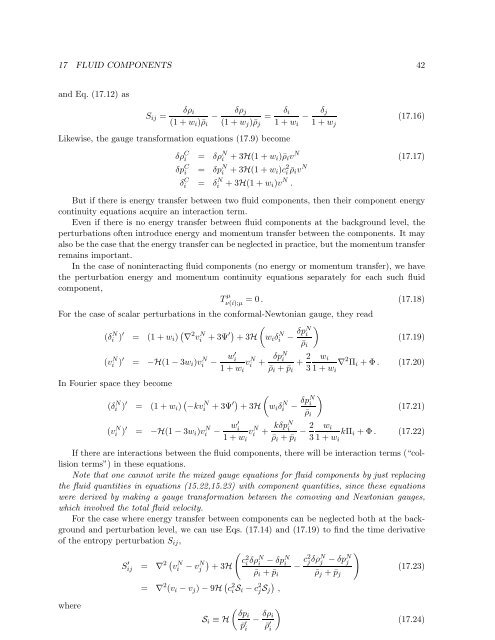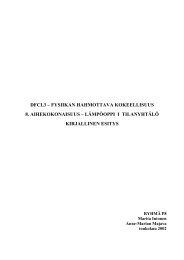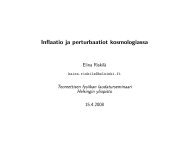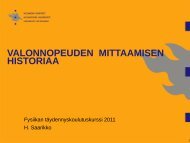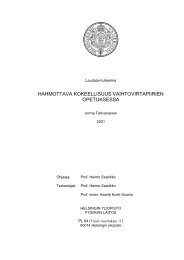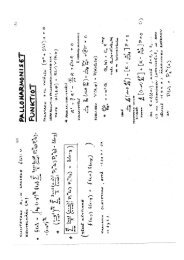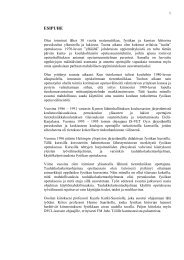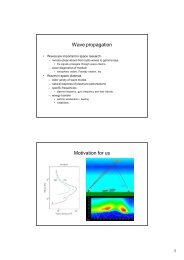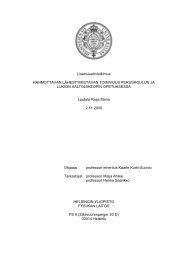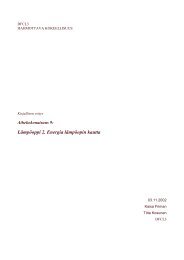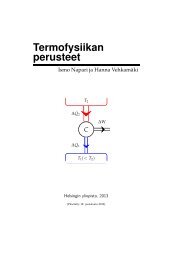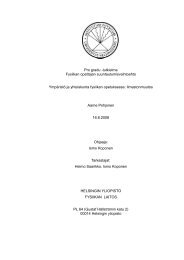Cosmological Perturbation Theory, 26.4.2011 version
Cosmological Perturbation Theory, 26.4.2011 version
Cosmological Perturbation Theory, 26.4.2011 version
You also want an ePaper? Increase the reach of your titles
YUMPU automatically turns print PDFs into web optimized ePapers that Google loves.
17 FLUID COMPONENTS 42and Eq. (17.12) asS ij =δρ i δρ j− = δ i− δ j(17.16)(1 + w i )¯ρ i (1 + w j )¯ρ j 1 + w i 1 + w jLikewise, the gauge transformation equations (17.9) becomeδρ C i = δρ N i + 3H(1 + w i )¯ρ i v N (17.17)= δp N i + 3H(1 + w i )c 2 i ¯ρ iv Nδp C iδ C i = δ N i + 3H(1 + w i )v N .But if there is energy transfer between two fluid components, then their component energycontinuity equations acquire an interaction term.Even if there is no energy transfer between fluid components at the background level, theperturbations often introduce energy and momentum transfer between the components. It mayalso be the case that the energy transfer can be neglected in practice, but the momentum transferremains important.In the case of noninteracting fluid components (no energy or momentum transfer), we havethe perturbation energy and momentum continuity equations separately for each such fluidcomponent,= 0. (17.18)T µ ν(i);µFor the case of scalar perturbations in the conformal-Newtonian gauge, they read(δi N ) ′ = (1 + w i ) ( ∇ 2 vi N + 3Ψ ′) ( )+ 3H w i δiN − δpN i¯ρ i(vi N )′ = −H(1 − 3w i )vi N − w′ ivi N + δpN i+ 2 1 + w i ¯ρ i + ¯p i 3In Fourier space they become(δ N i ) ′ = (1 + w i ) ( −kv N i + 3Ψ ′) + 3H(w i δ N iw i− δpN i¯ρ i)(vi N ) ′ = −H(1 − 3w i )vi N − w′ ivi N + kδpN i− 2 1 + w i ¯ρ i + ¯p i 3(17.19)1 + w i∇ 2 Π i + Φ . (17.20)w i(17.21)1 + w ikΠ i + Φ . (17.22)If there are interactions between the fluid components, there will be interaction terms (“collisionterms”) in these equations.Note that one cannot write the mixed gauge equations for fluid components by just replacingthe fluid quantities in equations (15.22,15.23) with component quantities, since these equationswere derived by making a gauge transformation between the comoving and Newtonian gauges,which involved the total fluid velocity.For the case where energy transfer between components can be neglected both at the backgroundand perturbation level, we can use Eqs. (17.14) and (17.19) to find the time derivativeof the entropy perturbation S ij ,S ′ ij = ∇ 2 ( v N i − v N j)+ 3H(c 2 i δρN i − δp N i¯ρ i + ¯p i= ∇ 2 (v i − v j ) − 9H ( c 2 i S i − c 2 j S j),)− c2 j δρN j − δp N j¯ρ j + ¯p j(17.23)where( δpiS i ≡ H¯p ′ − δρ )ii¯ρ ′ i(17.24)


